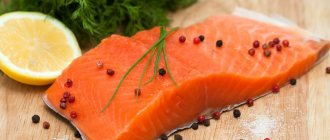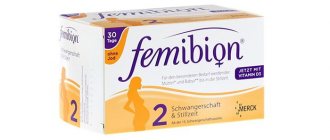A balanced diet for the expectant mother reduces the risk of possible complications in the development of the fetus and lays the foundation for the health of the child. Therefore, women are advised to follow a diet and take prenatal vitamin and mineral complexes. But there are substances that are difficult to obtain in adequate quantities by following all nutritional rules and taking multivitamins. I'm talking about omega-3 fatty acids.
As I wrote earlier in my articles “ Omega-3 for Adults ” and “ Omega-3 for Children ,” the fatty acids that are most important to humans are EPA and DHA. For children, pregnant and lactating women, the most significant is the latter - DHA. Timely and sufficient consumption of omega-3 fatty acids by a woman is important in the formation of the child’s brain, central nervous system and retina.
The third trimester is especially important in the development of a child. Doctors call him critical. At this time, the rapid development of the fetal brain begins. If a woman consumes little omega-3, the body depletes its own reserves.
The second critical period is the first six months of a child’s life. Fatty acids consumed in mother's breast milk are deposited in the baby's brain tissue. Accumulated fatty acids improve the permeability of cell membranes, the child’s body better absorbs nutrients, which affects his intellectual and adaptive abilities.
How to choose omega-3 for adult men and women read here: OMEGA-3 FATTY ACIDS, WHICH IS BEST TO BUY? FISH OR FISH OIL? OMEGA-3 OR 3-6-9?
Benefits for nursing mothers
Omega-3 is a group of polyunsaturated fatty acids that are necessary for the body to form nerve fiber sheaths, cell membranes, and connective tissue. These substances are beneficial for mother and child. A person needs about 1-1.5 grams of Omega-3 per day.
Polyunsaturated fatty acids are used especially actively during lactation. Half of the daily value is transferred through breast milk to the baby. Therefore, a woman needs to increase her Omega-3 intake.
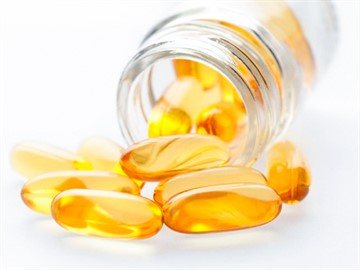
There are three types of polyunsaturated fatty acids:
- eicosapentaenoic acid;
- alpha-linoleic;
- docosahexaenoic.
A mother and her baby require the latter variety.
Benefits of Omega-3 for a woman’s body:
- improves the condition of arterioles and myocardium;
- reduces the likelihood of developing diabetes;
- reduces the risk of thrombosis;
- reduces bad cholesterol levels;
- stimulates brain function;
- improves the condition of joint tissue;
- promotes normalization of metabolic processes and weight loss;
- prevents postpartum depression, improves psycho-emotional state.
For a baby, the benefits of Omega-3 are as follows:

- promotes the formation of visual perception;
- ensures correct and timely development of the brain;
- improves abstract thinking, memory, increases concentration;
- prevents the development of infectious viral diseases, creating a barrier to the penetration of pathogenic microorganisms;
- strengthens the immune system;
- prevents the development of diathesis.
Signs of Omega-3 deficiency include the following:
- increased fragility of hair and nails;
- constant thirst;
- dryness of the epidermis;
- apathy;
- decreased concentration;
- poor wound healing;
- frequent constipation;
- increased blood pressure;
- pain in muscles, joints, tendons;
- a sharp decrease in immunity;
- deterioration in the quality of vision;
- decreased performance, fatigue;
- dandruff;
- the appearance of a rash on the skin.
Pediatrician Komarovsky strongly recommends that a woman take polyunsaturated fatty acids during lactation for the full development of the body of a newborn or infant.
Can I take it during lactation?
Omega-3 - this group of polyunsaturated fatty acids prevents the occurrence of diseases of the cardiovascular system, platelet formation, slows down or prevents inflammatory processes.
The drug is used to reduce the risk of developing insulin resistance and diabetes . Omega-3 fatty acids are required by the body for the formation of cell membranes, nerve fiber sheaths, and the formation of connective tissue.
During breastfeeding, Omega-3 PUFAs are actively used by the woman's body. At least half of the daily requirement is transferred to the baby through breast milk, which is approximately 2 grams.
The daily intake of a nursing mother should double and be 4-5 grams per day. There are three types of Omega-3 PUFAs:
- alpha-linolenic acid;
- eicosapentaenoic acid (EPA);
- docosohexaenoic acid (DHA).
A third type is needed for mother and child - DHA. Omega-3 is not synthesized or produced by the body on its own . You can only get it from food and dietary supplements. Most Omega-3 is found in seafood. But fish is not recommended for nursing mothers due to the possible increased content of radioactive substances, heavy metal ions, as well as the likelihood of developing helminthic infestation.
It is better to protect the body from such troubles. Therefore, at first it is safe to take Omega-3 medications as prescribed by your doctor.
The medical industry suggests taking Omega-3 in the form of fish oil capsules. 100 grams of fish oil contains 99 grams of Omega-3 PUFAs . But in 100 grams of cod liver there are only 15 grams, in 100 grams of walnuts there are only 7 grams of Omega-3 PUFAs. Based on the data, it is better to take 2-3 capsules of fish oil than 100 grams of nuts.
Information for vegetarian mothers: flaxseed oil will be the record holder for Omega-3 content. To replenish the daily requirement of Omega-3 you need to eat 2 tsp. linseed oil.
Ingestion
Omega-3 is included in many drugs. For example, this substance is sufficient in fish oil. The drug is available in capsule and liquid forms. It is considered a dietary supplement. Suitable for use during lactation. In addition to Omega-3, this product contains vitamins E, D, A.
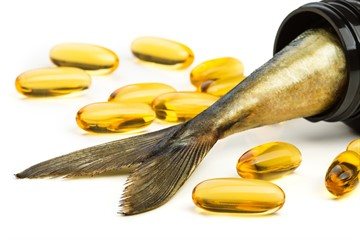
The drug prevents rickets, improves the condition of hair and skin, improves immunity and quality of vision, and has a beneficial effect on the functioning of the central nervous system. Previously, only fish oil was used to enrich the body with polyunsaturated fatty acids.
This drug was given to young children. The dosage is determined by the doctor individually in each case.
As a rule, the drug is prescribed in the amount of one teaspoon or 2-6 capsules per day (depending on the dosage of the drug). You should take no more than 1000 mg of fish oil per day. The course of treatment should not exceed a month. After 30 days, admission can be resumed.
During breastfeeding, women should choose fish oil with an Omega-3 concentration exceeding 15%. It is better to give preference to capsules: they are more convenient and pleasant to take. It is recommended to drink the drug during meals, preferably in the first half of the day.
Omega-3 during breastfeeding can be taken not only with fish oil. Today, pharmaceutical organizations offer a number of other drugs.
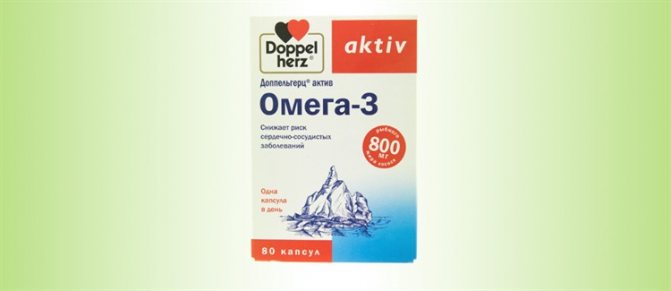
Capsules Doppelhertz active Omega-3
The following remedies are most suitable for women during lactation:
- Omega 3 from Now Foods;
- Solgar Omega 3;
- Doppelhertz active Omega-3;
- Vitrum cardio Omega-3;
- Omacor;
- Omega Forte Evalar.
These drugs have different concentrations of polyunsaturated fatty acids. Therefore, the dosage, frequency of administration and duration of the course are different. The optimal remedy should be selected by the doctor.
Beneficial properties of omega-3
Omega-3 is beneficial for the functioning of the nervous system and for activating brain activity. Omega-3 during breastfeeding is included in the baby's diet. The benefits of polyunsaturated fatty acids are obvious; we can distinguish the main groups that are affected by the consumption of omega-3.
Benefits of taking fish oil:
- proper metabolism;
- normalization of weight with regular use of acids;
- restoration of emotional state, fight against postpartum depression;
- increasing immunity;
- improving digestion and intestinal motility;
- increased brain activity;
- improving the performance of the cardiovascular system;
- reducing blood cholesterol levels;
- reducing the risk of blood clots;
- improving joint function;
- reducing the risk of stroke.
Due to the many positive effects, a baby needs omega-3 while breastfeeding. Komarovsky (a well-known pediatrician) believes that PUFAs are necessary for the full development of the child’s body.

External use
Omega-3 can be used not only orally, but also externally. Polyunsaturated fatty acids are used as an ingredient in the preparation of face masks.
They help improve skin elasticity, renew the stratum corneum, and prevent aging. Also, such substances strengthen hair and alleviate psoriasis. For external use, fish oil is usually chosen in liquid form. You should first consult a dermatologist.
Locally, fish oil is used to treat burn wounds and speed up the healing of scars. It must be remembered that this product can provoke an allergic reaction. Therefore, it should be used with caution. If a rash or itching appears after application, you should immediately wash off the fish oil from the skin with soap and water.
What do omega-3 acids affect?
- Nervous system. Polyunsaturated fatty acids have been proven to affect cognitive function. Another major study conducted in 2021* found a link between omega-3 levels in the diet and IQ levels.
- Vision. Omega-3 polyunsaturated fatty acids are involved in the formation of the retina of the eye, and, therefore, affect visual acuity!
- The cardiovascular system. Omega-3 acids are involved in the formation of cell membranes in the walls of blood vessels. In addition, polyunsaturated fatty acids slow down the formation of atherosclerotic plaques.
- The immune system. Small doses of omega-3 for children are known to stimulate the immune response. Yes, that's why we were forced to drink fish oil as children.
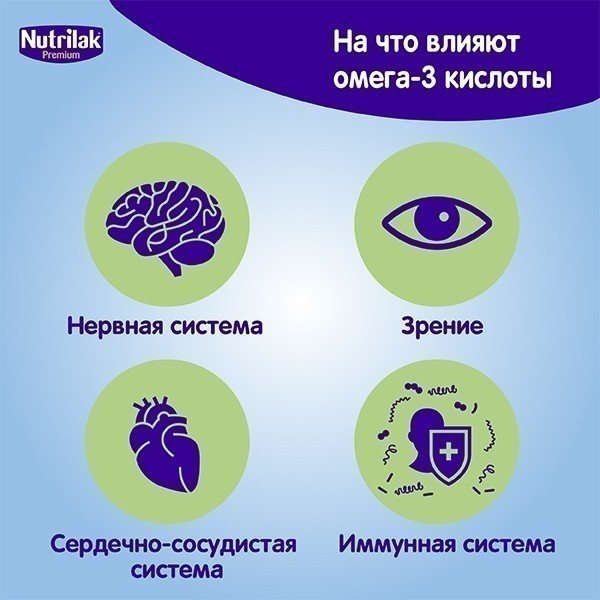
What products does it contain?
It is not necessary to take medications to enrich the body with polyunsaturated fatty acids. Omega-3 is found in some foods. Most of this substance is found in fish and seafood.
It is useful to eat red and black caviar, herring, tuna, mackerel, salmon, trout, salmon, halibut, and cod. It is recommended to stew or boil the fish. It is important to remember that seafood is prohibited in the first months after childbirth due to the high risk of developing an allergic reaction.
Omega-3 is also found in the following foods:
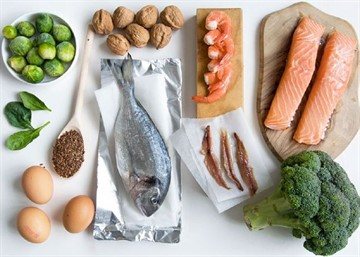
- flaxseed, sesame, olive, rapeseed oils;
- canned cod liver;
- dried soybeans;
- Brussels sprouts;
- chickpeas;
- oat seedlings;
- walnuts;
- lentils;
- Brown rice;
- wheat germ;
- dry beans;
- pistachios;
- chicken eggs;
- pecans;
- spinach;
- almond;
- avocado oil;
- pumpkin seeds.
It should be taken into account that polyunsaturated fatty acids can change the taste of milk. As a result, the baby may refuse to breastfeed.
The mechanism of action of Omega-3 in the child’s body
Let's imagine that a cell in our body is a closed sandwich. The bread then becomes the membrane or shell of the cell. Omega-3 here plays the role of the main ingredient - flour.
You can't see the flour in the sandwich. But without it the dish will not work. In the same way, without Omega-3, the cell is not able to fully function. The main one in the omega-3 class, which is most important for the development of children, is docosahexaenoic acid (DHA) - therefore, most often the calculation in food products and dietary supplements is based on it.

Contraindications and precautions
It is important to remember that uncontrolled and prolonged use of drugs containing Omega-3 can negatively affect the health of a woman and her baby. Therefore, it is necessary to follow the instructions and not exceed the recommended dose.
Taking Omega-3 may worsen the course of the following diseases:
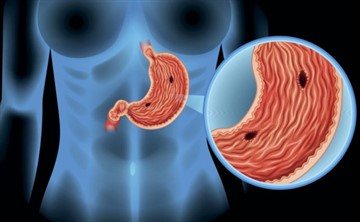
- intestinal or stomach ulcer;
- chronic pathologies of the kidneys, gall bladder, liver;
- hypervitaminosis;
- hypercalcemia;
- thyroid disease.
With long-term use of drugs with polyunsaturated fatty acids, the fat content of milk can increase and stagnation in the mammary glands may occur. Therefore, while taking medications containing Omega-3, it is worth reducing the amount of fatty foods in the diet.
It is also likely that your baby will develop problems with the digestive tract: colic, upset stool. Allergic reactions in the form of an itchy red rash on the body are possible.
Among the side effects, women sometimes experience:

- decreased blood clotting;
- bad odor from the mouth;
- diarrhea.
You should stop taking Omega-3 in the following cases:
- individual intolerance to this substance by the body of a woman or her child;
- ulcerative pathologies;
- cholelithiasis and urolithiasis;
- endocrine disorders;
- organic myocardial diseases;
- hypothyroidism;
- disorders of the liver (fatty hepatosis, hepatitis);
- active form of tuberculosis;
- chronic renal failure.
To prevent the development of adverse reactions while taking Omega-3 drugs, doctors advise the following:
- start taking the medicine with the minimum dosage. This will make it clear how the child’s body reacts to the introduction of polyunsaturated fatty acids. If no negative symptoms appear during the first day, the dose of the drug can be increased;
- take suitable means;
- follow the rules for using the medicine specified in the annotation;
- do not take the drug for too long and in large doses;
- if adverse reactions occur, immediately discontinue Omega-3;
- stop taking medications containing polyunsaturated fatty acids in the first three months after birth. Newborns are weak and sensitive. Their digestive and immune systems are not formed. At this time, the baby’s fragile body may react to Omega-3 with allergies and gastrointestinal disorders.
Video on the topic
About the benefits and possible harm of Omega-3 in the video:
Thus, preparations with polyunsaturated fatty acids are necessary for women after childbirth who are breastfeeding and do not receive a balanced and nutritious diet. Omega-3 has a beneficial effect on the condition of the mother and her child. But this drug must be administered carefully, taking into account the likelihood of side effects and the presence of contraindications.
Will fish oil in a mother’s diet harm breastfeeding (BF)? How will this dietary supplement affect lactation? What beneficial properties are most important for a nursing mother and her baby, and what are the contraindications?

Photo: .com. puhhha.
Omega-3 for a child
After the baby is born, some of its organs are not fully formed. The nervous system continues to mature. The gastrointestinal tract is colonized by bacteria. The eyes and visual system are actively developing. The immune system continues to strengthen and depends on what the mother eats.
Inside the mother, the child took all the necessary vitamins from her body, and after birth he feeds on breast milk.
Omega-3 plays an important role in the development of a child’s immunity, brain and vision development. Is it possible for a nursing mother to take omega-3 while breastfeeding?
Omega-3 is involved in the cellular construction of the brain and eyeball. Cells require fats and eicosapentaenoic and docosahexaenoic acids for proper formation. They are found in fish oil and are absent in vegetable fats. Therefore, it is important for a child to receive polyunsaturated fatty acids from birth.
If mother's milk contains PUFAs in sufficient quantities, the child will receive them. Properly selected vitamins help compensate for poor nutrition. And if fish does not appear often in your diet, then capsules with fish oil are necessary.

Benefits for mother and baby
Fish oil is a dietary supplement made from the liver of cod fish. Many adults perceive it as something tasteless and smelling bad. Fortunately, advanced pharmaceuticals offer us not only to drink liquid fish oil, familiar from childhood, but also to take its purified analogue in capsules.
The exclusivity of the product lies in the content of a large amount of vitamins (A, E, D, etc.) and fatty acids, without which the human body cannot fully function.
Vitamin A is essential for good vision. Together with vitamin E, it is responsible for the condition of nails, skin and hair (many mothers who breastfeed their children note a deterioration in their condition).
Vitamin D helps in the absorption of calcium and phosphorus, which are necessary to strengthen the teeth and bones of a nursing mother. If there is a deficiency of this vitamin in the body, rickets develops. The disease is also dangerous for a baby because only a doctor can notice it. The vitamin is especially important for “winter” children, since in the first months of their life they usually experience a lack of sunlight.
Separately, it should be said about the importance of fatty acids, which:
- stimulate fat metabolism and have a beneficial effect on digestive processes;
- have a positive effect on the development of the children's nervous system;
- promote the production of the hormone of joy - serotonin, and therefore serve as a prevention of depression in nursing women;
- eliminate inflammatory processes;
- form immunity in the baby and strengthen the protective forces of the mother’s body;
- reduce cholesterol levels and prevent the occurrence of heart and vascular diseases;
- help wound healing;
- necessary for the formation of nerve fibers, cell membranes and connective tissue;
- prevent the onset of diabetes.
Regular intake of fish oil by a woman during breastfeeding promotes lipid metabolism, which, in turn, helps to get rid of extra pounds that “settled” in the body during pregnancy.
What is fish oil?
Fish oil is most often produced from the liver of cod fish. The liquid form has a characteristic odor that cannot be confused with any other. The capsules are yellow in color and have no odor. The product is considered a dietary supplement and is available without a prescription.
To strengthen the immune system, take fish oil. In Soviet times, they drank it to prevent rickets in children. Fish oil contains not only omega-3, but also various vitamins.
Vitamin A affects vision, improves the condition of hair and nails, and improves immunity. Vitamin A deficiency affects the skin, causing excessive dryness.
Vitamin D improves calcium absorption and is responsible for the functioning of the nervous system.
Vitamin E has a positive effect on the condition of the skin and the function of the reproductive system.
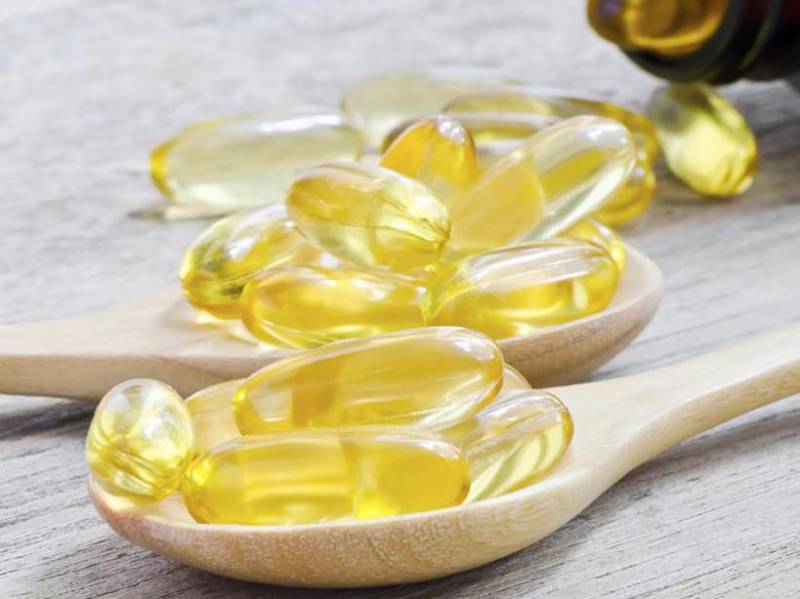
Contraindications
Despite the undeniable benefits of this dietary supplement for breastfeeding, its use should be treated with caution and all existing contraindications should be taken into account:
- sensitivity to components of fish oil and individual intolerance;
- pathologies in the gastrointestinal tract;
- kidney diseases;
- liver problems, including hepatitis and fatty liver disease (fatty liver);
- cholelithiasis;
- diseases of the heart and blood vessels;
- hypothyroidism and hyperthyroidism.
If you have a history of food allergies to seafood, don't rush into taking fish oil. It is better to consult an allergist.
Contraindications and side effects
Long-term, uncontrolled use of the drug can provoke and aggravate a number of diseases:
- chronic diseases of the gallbladder, kidneys, liver;
- ulcerative formations in the stomach, small intestine;
- increasing the content of vitamin D and calcium in the body;
- pathological manifestations in the functioning of the heart and blood vessels;
- diseases of the thyroid gland.
A mother or child may have an individual intolerance to fish oil.
How to drink correctly
If you decide to take fish oil and at the same time breastfeed your baby, you should consult your doctor. During lactation, it is better to choose a nutritional supplement in the form of capsules. It is believed that this does not affect the smell and taste of breast milk.
You should start taking it with one capsule, after which a break is necessary, during which the mother can observe the condition of the baby and his reaction to the drug.
During this period, the woman needs to refrain from eating new foods that are not yet familiar to the baby, so that in the event of an allergy there is no doubt about the causes.
If there is no reaction, after 2-3 days you can take fish oil daily in the dosage prescribed by your doctor.
The average daily dose is 1 tsp, or 1-3 capsules.
In order to prevent colic in the baby due to changes in the composition of milk, the mother needs to monitor the amount of fat in her diet and avoid fatty foods. Compliance with this recommendation will also significantly reduce the risk of lactostasis, which is often caused by mother’s milk being too fatty.
Russian doctors advise taking the drug in the autumn-winter period according to the following scheme: 1 month on - 1 month off.
Can I take fish oil and Omega-3 while breastfeeding?
Many women, fearing harm to the baby, try to avoid taking any medications during lactation. However, it is hardly worth giving up fish oil and Omega-3. To cast aside any doubts, you must first understand what kind of supplement it is and what benefits it brings.
Fish oil has been known to many since childhood. More than one adult remembers with horror how his parents ran after him with a spoon, begging him to drink the contents, promising all sorts of rewards. At that time, few people understood why this “disgusting” oil was needed. But the parents were absolutely right, since fish oil is a unique preparation containing vitamins D, A, E, as well as polyunsaturated acids , the most important of which are eicosapentaenoic acid (EPA) and docosahexaenoic acid (DHA).
5 components of fish oil that are indispensable for women and children during breastfeeding:
- Vitamin D is important for the formation skeleton and the rapid healing of the fontanel.
- Vitamin A is indispensable for the vision of both the baby and his mother. In addition, its wound healing and anti-inflammatory properties are known.
- Vitamin E (fat soluble) is important for building and strengthening immunity . Its deficiency causes anemia in both the child and the mother.
- Omega-3 - polyunsaturated acids are involved in the construction of tissues , nerve fibers, cells in both women and children.
Which fish oil to choose?
The Russian company produces food supplements under the brand name “ Biafishenol ” - 21 types of fish oil capsules with various herbal additives: valerian, wheat germ, flax oil, kelp and others.
Biafishenol fish oil, three facts are worth highlighting:
- The preparations are made from the carcasses of wild fish. This is important because such fish eat normally, unlike artificially grown ones.
- Raw materials for the drugs are exported from Iceland and undergo deep cleaning and three levels of quality control.
- There are fish oils with PUFA content of 38% and 55%. This is important in the context of the individual needs of the body.
Biafishenol fish oil , with a high level of quality, is distinguished by its affordable price, which reflects the general policy.
Cosmetic bonuses
Fish oil is a multifaceted product and, among other things, has a positive effect on women’s appearance. This dietary supplement contains a lot of vitamin E, which is called the “vitamin of beauty and youth.” Regular use slows down the natural aging of the skin, restores elasticity and starts regeneration processes.
The scope of application of fish oil is not limited to oral administration. Homemade masks have demonstrated high effectiveness. It is important that even those mothers whose children are allergic to the drug can use them. With this use, potential allergens do not penetrate into breast milk and therefore cannot harm the baby.
To prepare homemade cosmetics based on fish oil, you can use both liquid preparation and capsules. Let's look at a few recipes.
Face masks
- Combine bee honey, liquid fish oil and water in equal quantities (1 tablespoon each). Mix everything until smooth and apply to facial skin. After 30 minutes, rinse with warm water without soap.
- 1 tbsp. l. combine fish oil with the same amount of heavy cream and lemon juice. Mix all ingredients. Apply to face for 20 minutes. It is recommended to rinse off with warm water.
- For dry and flaky skin, split 2 capsules of fish oil and mix the contents with 1 tbsp. l. dry yeast and 2 tbsp. l. warm milk. Wait 15-20 minutes (during this time the yeast should activate). Next, add the egg yolk to the mixture and mix until smooth. Leave on the skin for 20 minutes, then rinse with warm water.
Hair Mask
- Mix egg yolk in equal proportions with fish oil, honey, burdock, olive and almond oils. The volume of the mixture will depend on how long and thick your hair is.
- Heat the components in a water bath to a temperature comfortable for the skin.
- Distribute the mixture evenly throughout your hair and leave for 30 minutes.
- Rinse thoroughly with shampoo.
This should be done at least once a week.
Nail care
To strengthen your nails, you need to mix fish oil, lemon juice, olive and sea buckthorn oils in equal proportions. Apply the resulting mixture to your nails and leave until completely dry. This nail strengthening method will show noticeable results if done once a week.
Reviews from young mothers
Natalya: I am the mother of two wonderful twins. My pregnancy was not easy, because the load on the body was double. After giving birth, I felt incredibly tired, constantly wanted to sleep, and depression set in. The doctor advised me to drink fish oil capsules (1 piece 2 times a day for a month). I was very worried about how this would affect my children, since we are on breastfeeding. But they tolerated the drug perfectly. A month later, my health improved noticeably. A pleasant bonus was the wonderful condition of my hair and skin.
Victoria: After my first birth, my hair fell out a lot. I even thought that I would have to buy a wig. But as it turns out, this is a common problem for women who are breastfeeding. Therefore, when I became pregnant with my second child, I immediately began studying this topic. My gynecologist advised me to start taking fish oil during pregnancy. I took it in courses: one month after another. The baby was born healthy, and my luxurious hair still causes the envy of my friends.
I recently read an article that I wanted to share with you. Precisely because it is called “Misconceptions about the nutrition of nursing mothers,” I will allow myself comments from the point of view of healthy nutrition.
The way of eating in which both you and your child will receive all the necessary nutrients and at the same time lose weight is described in the post
The process of feeding a child is so natural that it would be strange if its success directly depended on the mother’s nutrition. In this case, few babies would survive today in poor countries and in earlier, prehistoric times.
As modern research shows, the level of fat, vitamins and minerals in breast milk does not depend on the diet of the nursing mother.
The amount of protein, as has been known for a long time, also has a certain meaning under any conditions. Nature intended that during pregnancy a woman accumulates everything she needs to feed her baby.
Fat deposits and reserves of nutrients accumulated over 9 months are gradually consumed over the next 6-9 months. It is due to the reserves that the uninterrupted production of always healthy and satisfying milk is ensured, regardless of the number of meals or the quality of the products.
(E.L) This fact allows long-term nursing mothers to restore their figure naturally, please note! The important point is that at the end of feeding, if eating patterns have not changed, the weight returns.
The amount of milk depends only on hormones, which tell the body how much milk needs to be produced for the next feeding.
These hormones are released when the baby suckles at the breast. Therefore, the most effective way to increase lactation is to put the baby to the breast as often as possible and not finish feeding until the baby releases the nipple.
How much should you eat?
Perhaps one of the most persistent misconceptions is that a breastfeeding woman is obliged to eat for two. Otherwise, the baby will not have enough milk.
Studies on poorly nourished breastfeeding mothers found that increasing their caloric intake did not affect the amount of milk they produced. The extra calories went into the mother's fat reserves, and not into her milk. And this is understandable, because it has long been proven that the amount of milk depends to a large extent on the quantity and quality of breastfeeding.
In this regard, modern recommendations say: it is enough for a nursing mother to add one meal (if she did not do this during pregnancy). This could be a second, light dinner or breakfast, during which she will eat an additional 300-500 kcal. This is approximately how many calories an infant consumes per day.
You need to eat often, but in small portions, following the principles of food combinations.
About the need for a diet
On the one hand, a nursing mother is forced to eat to her fullest, on the other hand, they are told from all sides that it is impossible to eat specific foods, excluding a good half of the food that is healthy and necessary for a woman.
This applies to everything that can increase gas formation (this is not only cabbage and legumes, but also bread, grapes), as well as potential allergens (citrus fruits, strawberries, honey, nuts, eggs, even milk). It also includes pork and fatty fish. Various sources can add many more restrictions to this list.
Fact
In its pure, unprocessed form, only artificial food additives (dyes, preservatives, stabilizers, etc.) and some medications penetrate into milk.
So what can a nursing mother eat?
In fact, almost everything! To understand this, it is enough to understand the process of milk synthesis.
Food eaten by a woman enters the gastrointestinal tract, is digested, and the substances it contains are absorbed by the intestinal walls and enter the blood. Next, the mammary gland produces milk from the mother's blood and lymph. That is, all fermentation processes from cabbage remain in the intestines, and allergens are safely processed in it.
(E.L.) This, in my opinion, is the main point in the QUALITY of milk supplied to the baby. The state of the gastrointestinal tract, blood and lymph are the sources from which milk is produced. The sources must not be contaminated! But in fact, the intestines and lymph and blood of 90% of people are contaminated due to poorly functioning filtering organs (liver, kidneys) and poor gastrointestinal tract condition.
When I was feeding my eldest, losing weight and cleansing the body naturally, I saw how the child’s diathesis went away without pills and there were no more allergic manifestations.
It’s another matter if the mother’s body reacts too violently to cabbage or milk, or if the mother is sensitive to citrus fruits.
Increased gas production by the mother changes the composition of her blood, which means it could potentially affect breast milk.
(E.L.) Increased gas formation is caused by the state of the gastrointestinal tract, putrefactive processes occurring in it, poor nutrition and a combination of products when pathogenic microflora predominates.
But even in this case, the child will not necessarily react to the vegetable stew eaten by the mother for lunch. It’s the same with allergies: with an allergic mother, the child is more likely to be sensitive to the same products, but not always.
(E.L.) Allergy is an acute reaction of a contaminated body
The most important thing is that, while in the womb, the child has already become familiar with many foods and even allergens. And if substances from such products continue to be supplied in small doses through mother’s milk, the baby’s body will gradually learn to cope with them.
In this case, when complementary foods are introduced, the child is less likely to have an allergy or other inappropriate reaction.
Milk and cottage cheese
Another horror story: if she doesn’t drink milk, she won’t have any; If he doesn’t eat cottage cheese, the child will have weak bones, his teeth won’t grow, and his mother’s teeth will fall out.
But which wild animal drinks milk to improve lactation? And no one feeds them cottage cheese.
Milk is healthy in itself, as it contains many useful substances. And you can and should drink it, without fanaticism, but only if the mother wants it, and if her body digests milk well.
(E.L.) The question of the benefits of milk today is a controversial issue. Authorities convincingly prove their points of view, which are often opposite. If you replace milk in your and your child’s diet with fermented milk products (not from the supermarket), this will significantly make your life easier and reduce the occurrence of allergic reactions.
The same goes for cottage cheese. The product is healthy, but forcing yourself to eat it, even for the sake of your child, is not worth it. Food eaten without desire and appetite will not be accepted by the body, and therefore will not be beneficial. That's how we are made.
Both milk and cottage cheese are successfully replaced with other products: cheese, kefir or yogurt, salmon fish, legumes, cabbage, fresh herbs, carrot juice, raisins and dried figs.
Onions, garlic, spices and other flavors
Another well-known myth: a child may refuse to breastfeed if the mother ate onions or garlic. Scientists have tested this statement. It turned out that no strong-smelling foods or seasonings can curb a baby’s appetite. Moreover, after the mother eats garlic, the baby sucks with greater desire and applies more often.
(E.L.) At the same time, both onions and garlic have antiparasitic properties, which in itself cleanses the internal fluids from which milk is formed.
Important!
The cause of problems that arise during breastfeeding, as a rule, is not the nature of the mother’s diet, but other factors, such as the nervous environment in the home, difficult adaptation, immaturity of the gastrointestinal tract, immune system and other organs and systems of the baby.
(E.L.) At the same time, both onions and garlic have antiparasitic properties, which in itself cleanses the internal fluids from which milk is formed
Fatty foods
The old school argued that the fat content of milk depends on the caloric intake of the mother and how much fatty foods she eats.
In fact, it turned out that the fat content of breast milk depends on many reasons, among which the quality of nutrition is one of the least significant.
(E.L.) For the fat content of milk - yes, but for the health of mother and baby - the most important thing!
First of all, the mother’s body responds to the baby’s needs. The state of the environment matters (in the summer, in the heat, fat is harder to digest) and the time of day (at night the child must sleep, and the calorie content of milk increases due to the fat content).
Also during feeding, milk from one breast has different fat content. The fattest milk that the baby sucks out at the end.
Recommendations regarding the fat content of foods are general: you should not load your body with excess fat, but low-fat foods are not healthy either.
How much to drink?
They say that you should drink up to 2 liters of fluid per day. Moreover, you should drink a glass of some drink before each feeding. Otherwise there will be little milk.
Considering modern recommendations about feeding on demand, it is scary to imagine that, following old recommendations, a woman will have to drink up to 20 glasses of water in the first month. Add the liquid you get during each meal.
However, modern medicine knows that if there is excess fluid in the body, it is difficult for it to “give” milk, that is, stagnation can easily occur. But a nursing mother should not feel thirsty. So listen to your body and drink exactly as much as you want.
Coffee
The previous recommendation to give up coffee and other caffeine-containing drinks and medications has now also been adjusted. A strange recommendation, considering that caffeine is also present in significant doses in tea, especially green tea, which mothers are even strongly advised to drink.
Although, indeed, some babies have sleep disturbances due to caffeine and become capricious. However, if during pregnancy the mother allowed herself a cup of coffee in the morning, most likely the baby is already accustomed to this substance. And after his birth, you can carefully try weak coffee. Most likely, there will be no reaction from the baby.
In addition, some women physically cannot do without coffee in the morning. How will a mother take care of her baby if she cannot get out of bed?
(E.L.) If you have a problem with “swinging” in the morning, adjust your daily routine. Go to bed earlier, do not eat before bed. Then in the morning you will get up cheerful and energetic, and not tired and lethargic.
You should not drink coffee because it removes the fluid the body needs. It is better to replace it with herbal teas or bran with honey. This will trigger intestinal peristalsis for those who have problems with stool.
Vitamins
To ensure that milk contains enough nutrients, a woman needs to take special multivitamins. That's what they thought before.
The female body is designed in such a way that during the feeding of the child it gives up all its reserves, both fat and reserves of vitamins and minerals. Therefore, it does not matter for the quality of breast milk whether a woman takes vitamin supplements. In this case, it is more important for her to eat rationally, since if there is a lack of vitamins in the diet, the mother’s body will suffer first. And there will always be resources for the development of the baby’s body.
Therefore, taking vitamins with a proper diet and proper daily routine is not at all necessary. But if you decide to play it safe, then take frequent breaks when taking multivitamin medications. For example, after 2 weeks of taking it, put it off for another 2 weeks. This way you will be sure that the ratio of vitamins in the body will be at the correct level.
(E.L.) Multivitamins have so many hidden actions that it is better to learn how to get all the necessary vitamins from food, in my opinion.
Fact
Human milk has a high level of nutrients until the child reaches 1.5-2 years of age. Even after this period, it does not become “empty” and even less “harmful”, as some doctors still claim.
Approach the issue of nutrition sensibly, eat fully, “correctly”, the same way you ate during pregnancy. Teach this to your children and then doctors will have less work. Do you agree?
A balanced diet for the expectant mother reduces the risk of possible complications in the development of the fetus and lays the foundation for the health of the child. Therefore, women are advised to follow a diet and take prenatal vitamin and mineral complexes. But there are substances that are difficult to obtain in adequate quantities by following all nutritional rules and taking multivitamins. I'm talking about omega-3 fatty acids.
As I wrote earlier in my articles “Omega-3 for Adults” and “Omega-3 for Children,” the fatty acids that are most important to humans are EPA and DHA. For children, pregnant and lactating women, the most significant is the latter - DHA. Timely and sufficient consumption of omega-3 fatty acids by a woman is important in the formation of the child’s brain, central nervous system and retina.
The third trimester is especially important in the development of a child. Doctors call him critical. At this time, the rapid development of the fetal brain begins. If a woman consumes little omega-3, the body depletes its own reserves.
The second critical period is the first six months of a child’s life. Fatty acids consumed in mother's breast milk are deposited in the baby's brain tissue. Accumulated fatty acids improve the permeability of cell membranes, the child’s body better absorbs nutrients, which affects his intellectual and adaptive abilities.
How much omega-3 should pregnant and breastfeeding women take?
The World Health Organization (WHO), the International Society for the Study of Fatty Acids and Lipids (ISSFAL) and other authoritative international organizations believe that pregnant and lactating women should receive a minimum of 250 - 300 mg of PUFAs per day, mainly DHA fatty acids.
The Japanese Ministry of Health recommends that pregnant and breastfeeding women consume up to 2 g of omega-3s daily. They also have quite high recommendations for children, and this is a country whose residents consume a lot of fatty fish.
Safe Sources of Omega-3 Fatty Acids
It is known that some fish breeds contain omega-3 in their fat, but fish tend to accumulate mercury and other toxic substances throughout their lives. For this reason, it is recommended that pregnant and breastfeeding women avoid regular consumption of fish and instead opt for fish oil supplements that have been independently clinically tested for their purity and quality as a source of omega-3.
*** Prenatal medications are suitable for both pregnant and lactating women.
*** When calculating the total amount of omega-3s, I counted only DHA and EPA as the most important.
Omega-3 Sources for Babies
The main sources of Omega-3 for children in the first year of life are breast milk or an adapted formula. The Omega-3 content in breast milk depends on the woman's diet. A breastfeeding woman should receive additional Omega-3 to meet the baby's needs.
How can a breastfeeding woman get Omega-3?
With food. *among food products, the leaders in the content of Omega-3 acids are considered to be: sea fish (salmon, trout, tuna), walnuts, seeds, avocado, spinach, chia seeds.
Important! It is recommended that a nursing woman consume foods with Omega-3 with caution, taking into account individual intolerance and to exclude an allergic reaction in the child.
- with specialized drinks for breastfeeding women with Omega-3
*for example, specialized nutrition for nursing women NutriMa Lactamil contains Omega-3 to ensure optimal content of Omega-3 fatty acids in the mother’s body and breast milk
- with dietary supplement Omega-3
WHO experts recommend 300 mg of Omega-3 for daily consumption by pregnant and lactating women.
Prenatal complexes
Nordic Naturals, Pregnancy DHA, Unflavored Formula, 500 mg, 180 Softgels (New Packaging)
Omega-3 - 685 mg. Servings - 90. Price of 1 mg of PUFA - $0.0008
The American Pregnancy Association recommends Nordic Naturals supplements as a source of omega-3 for pregnant women. According to the manufacturer, each batch of their fish oil is tested by independent laboratories for the presence of toxins and heavy metals. All fish oil is supplied in triglyceride form and meets the strictest international standards for purity and freshness. This supplement contains 100% of the daily value of vitamin D3. Keep this in mind if you are taking a vitamin-mineral complex that likely contains vitamin D.
Directions for Use: Take two capsules daily with food or as directed by your healthcare practitioner.
Buy at a discount
Carlson Labs, Nursing DHA, 500 mg, 120 Softgels
Omega-3 - 600 mg. Servings - 120. Price 1 mg of PUFA - $0.0004
A very profitable option from another cool manufacturer - Carlson Labs. Almost the same amount of omega-3 as in the top preparation, only 2 times cheaper. High omega-3 content and all in one capsule. Please note that this contains vitamin E. 1 capsule contains 35% of the norm. Select supplements so as not to overdose on vitamins.
Directions for use: Take one or two softgels daily with meals.
Buy at a discount
Minami Nutrition, More DHA, Lemon Prenatal Softgels, 60 Softgels
Omega-3 - 584 mg. Servings - 60. Price 1 mg of PUFA - $0.001
This complex is good because it does not contain any other vitamins; you can take any vitamin complexes with it and not worry about overdoses of individual vitamins. In addition, it turned out to be one of the most profitable in its category. That's why he's here.
Directions for use: Take one capsule daily with food.
Buy at a discount
California Gold Nutrition, Prenatal DHA, 450 mg, 180 Fish Gelatin Softgels
Omega-3 - 540 mg. Servings - 90. Price for 1 mg of PUFA - $0.0004
This drug is similar to Nordic, but it contains less fatty acids. But this amount fits into the norms, and the cost of 1 PUFA is two times lower than the version from Nordic. Why am I giving this drug? Because it is a house brand of iHerb (owned by iHerb) and there are often discounts on it. At a discount - an excellent profitable option.
Directions for Use: Take 2 capsules daily, preferably with food or as recommended by your healthcare practitioner.
Buy at a discount
Buy on iHerb at a discount
- New to iHerb? Get 12% off any order over $50! Use promo code NEW12 . The promotion is valid until March 31 and applies to new buyers from Russia, Ukraine and Kazakhstan.
Activate promotional code NEW12
- Promo code NIH688 gives a 5% discount on your entire order, regardless of the amount.
- Promo code VALUE60 gives you a 10% discount on your entire order when purchasing over $60.
- about weekly discounts for certain categories and brands here .
Postnatal omega-3. For women who are breastfeeding
Nordic Naturals, Postnatal Omega-3, Lemon, 650 mg, 60 Soft Gels
Omega-3 - 1042 mg. Servings - 30. Price 1 mg of PUFA - $0.001
A high content of both fatty acids is an important criterion for those who are breastfeeding. This complex contains two capsules containing the norm of omega-3 and vitamin D3 in a 250% dosage. This amount of fatty acids will be enough to support the health of both mother and child. Again, consider the presence of vitamin D in the composition. Check with your doctor about taking supplements.
Directions for Use: Two capsules daily with meals or as directed by your healthcare practitioner.
Buy at a discount
Fish oil, omega-3 during pregnancy and lactation
An important supplement during pregnancy is docosahexaenoic acid.
(DHA or DHA, which refers to omega-3 acids). The need for DHA increases dramatically as pregnancy progresses and the fetus's brain grows rapidly. This fatty acid is concentrated in the brain and retina, where it is an essential component of cell membranes.
It is not found in plants, only precursors (for example, alpha-linolenic acid in flaxseed oil), which are poorly absorbed. Conversion of ALA to EPA typically ranges from 0.2% to 9%, although some authors suggest that women of childbearing age may convert up to 21% of ALA to EPA. The conversion to DHA is even lower. High DHA content in fish oil. And not in every way. For certain purposes, this acid is isolated and concentrated. Plus, we must remember that fish accumulate heavy metals. Therefore, fish oil should be as free from mercury as possible. Nordic's prenatal fish oil is 400 times purer than the established norm. This is one of the best manufacturers, and maybe the best.
Why is DHA recommended for pregnant women?
Because they noticed and later conducted research according to which a sufficient amount of this fatty acid during pregnancy gives children greater intelligence, so to speak, in the first years of life. Infants whose mothers received up to 600 mg/day of DHA in the last two trimesters had high levels of sustained visual attention before the age of one year. Although recently the benefits of DHA have been disputed. Also, in a number of studies, higher blood concentrations of DHA were associated with better visual acuity and mental and psychomotor skills at 6 months and 11 months. Supplementing with DHA during pregnancy is thought to reduce the likelihood of preterm birth (before 34 weeks B). And it provides a small reduction in postpartum depression in women with a history or high risk of depression. According to other studies, not only DHA is important for pregnant women, but also EPA (eicosapentaenoic acid, EPK), but in smaller quantities than for ordinary people. EPA is a precursor to the 3rd series of prostaglandins, which promote relaxation of the myometrium (obviously, if there is tone, then this supplement will work to reduce it). EPA helps the fetus absorb DHA.
Therefore, simply adding any fish oil may not meet the needs of a pregnant woman; most likely, the content of these acids will be clearly insufficient, plus the question of the content of heavy metals remains open. So I chose a specific supplement: Nordic Naturals, Pregnancy DHA, Unflavored Formula, 500 mg, 180 Softgels
.
This supplement contains EPA 205 mg, DHA 480 mg, vitamin D 400 IU in two capsules.
Femibion II contains only DHA at a concentration of 200 mg per capsule. This is the daily norm.
The studies used higher dosages (400, 600, 920, 1183 mg), so you can drink one at a time, focusing on femibion, or drink two, as the manufacturer recommends.
Omega-3 fatty acids also appear to be important during lactation.
Breastfeeding women who received 200 mg of DHA per day for 4 months had children who improved significantly on the Bayley Psychotherapy Development Index over 30 months, compared with women who received a vegetable oil supplement.
In addition, fish oil supplementation taken during pregnancy and lactation resulted in a reduced risk of allergy development
in newborns. Women with allergies or with a spouse or child with allergies were randomized to receive 2.7 g of omega-3 fatty acids or placebo starting at 25 weeks of pregnancy until 3 to 4 months of lactation. During the first 12 months, infants born to mothers in the omega-3 group had a reduced risk of developing food allergies and IgE-associated eczema.
For the postnatal period
(after childbirth),
Nordic also has fish oil, with a different proportion of EPA and DHA.
It's on my list: Nordic Naturals, Postnatal Omega-3, Lemon, 650 mg, 60 gelatin capsules
. Contains EPA 586 mg, DHA 456 mg, Vitamin D3 1000 IU in two capsules. The supplement is designed to support positive mood and optimal health after childbirth, to support motherhood awareness and continued neurological development in infants.
See also:
Prenatal vitamins
Calcium and magnesium during pregnancy






